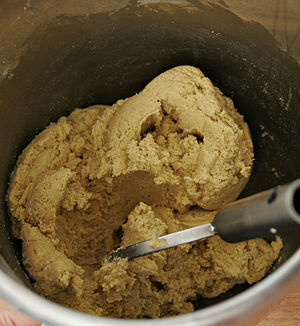 |
| Dough (Photo credit: Wikipedia) |
This blog, Slow Bread, was originally launched about four years ago (in 2008) and is devoted to No Knead Baking. The original no knead bread recipe which launched this blog is still presented below in its entirety in the post now titled Classic Basic Bread Recipe. It still stands and is a fine recipe, if you wish to try it.
The problem is that the blog author has discovered an even quicker and handier recipe. As a result, for his own bread he has abandoned the Classic Basic Bread Recipe and now uses the newer recipe presented in this post, which is labelled No Knead Bread At The Ready 24/7/365. The idea for this revision comes from a blog post (the address of the post has been misplaced, so here is the web address of a book based on the original post). In any case, here is your route to delicious bread, rolls or pizza dough when you want it:
In an ample container (I use a food-grade plastic container which is not too tall for inside the refrigerator)
...mix 7 to 8 or more cups of flour (use your preferred combination of all-purpose, bread, whole wheat, soy bean (in small amounts) or any other bread-appropriate flour you like -- if you are unsure, start with 100% of any flour you typically use to bake bread)
...mix in about 1 tablespoon salt and about a half a teaspoon of active dry yeast (which usually comes in large packages or bottles, not the yeast that comes in the foil three-packs).
FWIW, I have never measured any of the dry or wet ingredients exactly. This recipe works well even when measurements are inexact and only close approximations.When the dry ingredients are combined, add half the volume of water as the volume of flour you have used (for example, seven cups of flour needs three and a half cups of water, and so on). Mix well (make sure there are no dry patches of flour hiding on the very bottom of the container).
Let the dough sit at room temperature for about 4 hours. It should rise nicely during this resting period. If it has risen nicely, cover loosely with the container lid. Place the loosely-covered container of risen dough into the refrigerator.
For the next two weeks you have dough at the ready for baking. Whenever you want to bake, scoop out a portion of dough, allow the portion you have scooped to reach room temperature (about 20 minutes), then bake it the same way you would bake dough made from scratch (see all the dozens of bread recipes in this blog). That usually means bake the dough for about 25 minutes in a 450 degree oven. The unused portion of dough is at the ready for you for about two weeks from its date of birth. Keep the unused portion of dough in the loosely-covered container in the refrigerator. Use the remaining dough whenever you want to bake.
Dough which has been made and stored in this fashion is less sticky to the hands than no knead dough made in the manner described in the other recipes on this blog. That means that if this recipe's pre-refrigerated dough is sprinkled with a bit of flour and the hands of the baker are lightly floured the dough can be shaped. Shape it as you like. If you wish to make a pizza, the dough can be hand-shaped and stretched quite easily.If you make bread or rolls, the outside crust of the bread or rolls are crisper if there is a container of hot water in the oven during baking. If the oven is preheated at 450 degrees for ten or more minutes before the dough is put into the oven the bread "springs" upon baking. This "spring" gives the bread a chewier, more professional quality. Nice as that quality is, it is not absolutely essential. If for any reason preheating is skipped, the resulting bread or rolls are still quite tasty.
Baking time depends on the size and shape of the dough ball or balls. As noted above, 25 minutes at 450 degrees works for a softball-sized ball of dough. Rolls may take a bit less time. Flattened pizza dough also takes less time (to determine baking time I watch the doneness of the cheese on top).
When the dough in the refrigerated container is almost finished and needs to be replenished, add new dry ingredients and mix them with the remaining morsel of dough. In other words, mix the remaining old dough with the new ingredients. The small amount of old dough helps kick start fermentation of the new dough. Some claim this method produces the equivalent of sourdough. This kind of mixing old dough with new ingredients can be continued for many generations of dough, to your great pride and delight.Really, baking a nice loaf of bread, rolls or pizza is that simple. If this recipe doesn't work for you please send a comment and we'll see if we can fix your problem.








